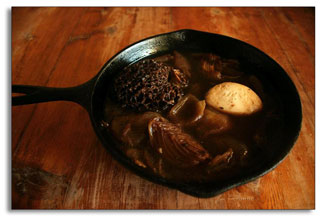|
|
Onion soup without tearsby Ari LeVaux Onions are in season right now, but few cooks are squealing for them like they do for divas like tomatoes and corn. Onions are typically supporting cast members, rarely the stars of the show, and few dishes are built around them. Nonetheless, onions are among the most essential supporting ingredients of all, right up there with oil, salt and pepper. Add white wine to that short list of essentials and you have the ingredients for French onion soup, one of the only dishes I know of that showcases the lowly onion. Legend has it King Louis XV invented the soup after arriving at a hunting cabin and finding only onions, wine and butter in the cupboard. I’d wager the king’s chef was the true soup savant that night, if anyone. But truth is, the average peasant’s larder would have been stocked with such ingredients as well, and perhaps not much more, on an average winter day. The creation of French onion soup was inevitable, and it was probably invented more than once. To this day, French onion soup is that rare bird among recipes that usually won’t require a trip to the store, because like the average French peasant most of us have the ingredients at home. And if you are out of onions, then a shopping trip is probably warranted anyway, because if you’re like me you can’t function in the kitchen without onions. The rich, concentrated flavor and warmth of onion soup is especially appealing as chilly weather settles in. And autumn is a sad time, when it feels OK to cry. But excessive crying over French onion soup isn’t necessary, according to Alain Ducasse, who lists among his many restaurants the Louis XV in Monte Carlo. Ducasse says keeping your knife sharp will reduce the number of tears you shed when making French onion soup, as less of the onion’s volatile and tear-jerking cellular fluids are released with the clean, smooth cut of a sharp blade. The impact of a sharp knife would be duly felt if following Ducasse’s recipe, which involves thin-slicing the onions. Not so much if you follow the method put forward by Nigel Slater, an Englishman no less, in his recipe, “Onion Soup Without Tears,” which appeared in his 2005 book The Kitchen Diaries. Slater’s onions are simply cut in half and slowly caramelized in the oven. This method requires fewer cuts, generating fewer tears. Slater’s method represents a minority opinion in the French onion soup-making community, as most recipes call for thin slicing. Another split, more evenly divided, is between those who caramelize their onions on the stovetop and those who do it in the oven. Many great chefs, including Julia Child, use the stovetop, while Slater and others prefer the oven. I prefer the oven, largely because I’m less likely to burn the onions if – i.e., when – I space out while cooking them. Slater advises to cut four peeled yellow onions in half (along the tip-to-root axis, as Ducasse also recommends). Bake them cut side down in a baking pan with two tablespoons of butter and a little salt and pepper. From here on I mostly follow Slater’s directive, though I deviate from time to time. Bake the onions at 400 for about 20 minutes, and then (deviating from Slater) reduce the oven temperature to 200. Stir gently, on occasion, until the onions are, as Slater describes, “tender and soft, and toasted dark brown here and there.” Deglaze with shots of white wine or water whenever the pan gets dry. If you caramelize the day before and refrigerate the pan of onions overnight (after letting them cool to room temperature), the following step will be easier: cutting the onion halves into the “thick segments,” as Slater advises. I cut my onion halves into thirds, along the tip-to-root axis. To these onions, add a cup of white wine (I went with a 2011 Bota Box Pinot Grigio). Then, as they say in England, “bring to the boil.” Once there, lower the heat to a simmer and let the wine reduce into a thickening sauce. Before it starts to burn, add stock from the bones of a red-meat animal, like beef, buffalo, venison or lamb. Use mushroom stock if you’re a veggie. I recently made the soup with stock from a fawn leg, into which I tossed a honking specimen from a jar of dried morels. If you don’t have time to make stock ahead of time, I recommend Better than Bouillon brand. Slater recommends the addition of six cups of stock. Add more if you want to stretch it, but the rich onion broth can only be stretched so thin before it loses its authority. Finally, bring the soup to the boil, and simmer for about 20 minutes. Though almost universally served under a floating cap of melted cheesy bread, here I leave Slater and return to Julia, who liked to serve French onion soup old-school style, with a poached egg on top. You should feel free to find your own way as well. There are so many variations on the simple combination of wine, onions and butter you could spend the rest of your life improvising. Which method you choose on any given day depends on how you’re feeling, how sharp your knife is, and how attached you are to your tears. |
In this week's issue...
- January 25, 2024
- Bagging it
State plastic bag ban is in full effect, but enforcement varies
- January 26, 2024
- Paper chase
The Sneer is back – and no we’re not talking about Billy Idol’s comeback tour.
- January 11, 2024
- High and dry
New state climate report projects continued warming, declining streamflows


